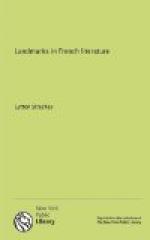The new movement had been already faintly discernible in Diderot’s bright colouring and the oratorical structure of Rousseau’s writing. But it was not until after the Revolution, in the first years of the nineteenth century, that the Romantic spirit completely declared itself—in the prose of CHATEAUBRIAND. Chateaubriand was, at bottom, a rhetorician pure and simple—a rhetorician in the widest sense of the word. It was not merely that the resources of his style were enormous in colour, movement, and imagery, in splendour of rhythm, in descriptive force; but that his whole cast of mind was in itself rhetorical, and that he saw, felt, and thought with the same emphasis, the same amplitude, the same romantic sensibility with which he wrote. The three subjects which formed the main themes of all his work and gave occasion for his finest passages were Christianity, Nature, and himself. His conception of Christianity was the very reverse of that of the eighteenth century. In his Genie du Christianisme and his Martyrs the analytical and critical spirit of his predecessors has entirely vanished; the religion which they saw simply as a collection of theological dogmas, he envisioned as a living creed, arrayed in all the hues of poetry and imagination, and redolent with the mystery of the past. Yet it may be doubted whether Chateaubriand was essentially more religious than Voltaire. What Voltaire dissected in the dry light of reason, Chateaubriand invested with the cloak of his own eloquence—put it up, so to speak, on a platform, in a fine attitude, under a tinted illumination. He lacked the subtle intimacy of Faith. In his descriptions of Nature, too, the same characteristics appear. Compared with Rousseau’s, they are far bolder, far richer, composed on a more elaborate and imposing scale; but they are less convincing; while Rousseau’s landscapes are often profoundly moving, Chateaubriand’s are hardly ever more than splendidly picturesque. There is a similar relation between the egoisms of the two men. Chateaubriand was never tired of writing about himself; and in his long Memoires d’Outre-Tombe—the most permanently interesting of his works—he gave a full rein to his favourite passion. His conception of himself was Byronic. He swells forth, in all his pages, a noble, melancholy, proud, sentimental creature whom every man must secretly envy and every woman passionately adore. He had all the vanity of Rousseau, but none of his honesty. Rousseau, at any rate, never imposed upon himself; and Chateaubriand always did. Thus the vision that we have of him is of something wonderful but empty, something striking but unreal. It is the rhetorician that we see, and not the man.




